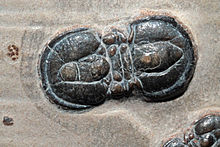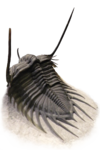
Trilobites are extinct marine arthropods that form the class Trilobita. Trilobites form one of the earliest known groups of arthropods. The first appearance of trilobites in the fossil record defines the base of the Atdabanian stage of the Early Cambrian period and they flourished throughout the lower Paleozoic before slipping into a long decline, when, during the Devonian, all trilobite orders except the Proetida died out. The last extant trilobites finally disappeared in the mass extinction at the end of the Permian about 251.9 million years ago. Trilobites were among the most successful of all early animals, existing in oceans for almost 270 million years, with over 22,000 species having been described.

Nektaspida is an extinct order of non-mineralised artiopodan arthropods. They are known from the mid-Cambrian to the upper Silurian. Originally classified as trilobites, which they superficially resemble, they are now placed as close relatives as members of the Trilobitomorpha within Artiopoda. The order is divided into three major families; Emucarididae, Liwiidae, and Naraoiidae.
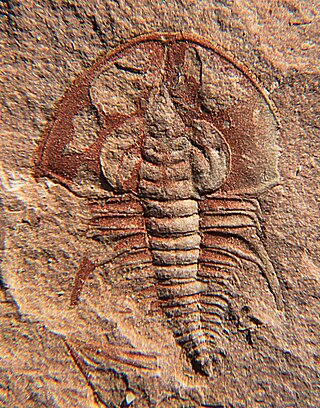
Olenellina is a suborder of the order Redlichiida of trilobites that occurs about halfway during the Lower Cambrian, at the start of the stage called the Atdabanian. The earliest trilobites in the fossil record are arguably Olenellina, although the earliest Redlichiina,Ptychopariida, and Eodiscina follow quickly. The suborder died out when the Lower Cambrian passed into the Middle Cambrian, at the end of the stage called Toyonian. A feature uniting the Olenellina is the lack of rupture lines in the headshield, which in other trilobites assist the periodic moulting, associated with arthropod growth. Some derived trilobites have lost facial sutures again, but all of these are blind, while all Olenellina have eyes.

Cheloniellida is a taxon of extinct Paleozoic arthropods. As of 2018, 7 monotypic genera of cheloniellids had been formally described, whose fossils are found in marine strata ranging from Ordovician to Devonian in age. Cheloniellida has a controversial phylogenetic position, with previous studies associated it as either a member or relative of various fossil and extant arthropod taxa. It was later accepted as a member of Vicissicaudata within Artiopoda.
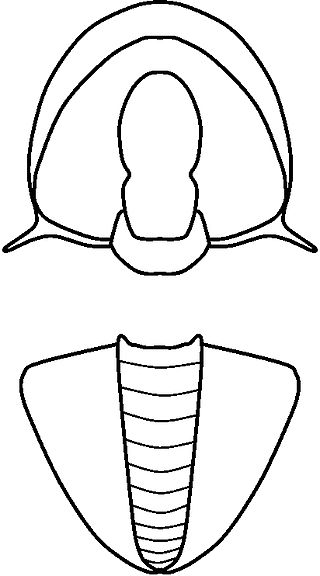
Acidiscus Rasetti, 1966, is a genus of Eodiscinid trilobite belonging to the family Weymouthiidae Kobayashi T. (1943), Order Agnostida Salter (1864). It lived during the Botomian stage = late Lower Cambrian Stage 4 ; the upper Botomian boundary corresponds to base of the Middle Cambrian, Miaolingian Series and Wuliuan stage.

Bolboparia is an extinct genus of eodiscinid agnostid trilobites. It lived during the late Lower Cambrian in what today Canada and the United States.
Stigmadiscus Rasetti, 1966, is a genus of Lower Cambrian Eodiscinid trilobite belonging to the family Weymouthiidae Kobayashi (1943) Order Agnostida It lived during the Botomian stage, = late Lower Cambrian Stage 4 ; the upper Botomian Stage boundary corresponds to base of both the Middle Cambrian Wuliuan stage and Miaolingian Series.

Tsunyidiscus is a trilobite belonging to the Suborder Eodiscina. Tsunyidiscus appeared near the end of the Lower Cambrian, during the late Atdabanian stage of geologic time and some collections suggest it may have survived into the Botomian. The genus is very small, oculate and isopypous with a narrow dome-shaped glabella and a narrow bullet-shaped pygidial axis. Thorax consists of three segments. Tsunyidiscus is the only genus currently attributed to the family Tsunyidiscidae.

Ptychagnostus is a member of the agnostida that lived during the Cambrian period. Ptychagnostidae generally do not exceed one centimetre in length. Their remains are rarely found in empty tubes of the polychaete worm Selkirkia. The genus probably ranged throughout the water column. It has two glabellar lobes, and three pygidial lobes.

Crustaceomorpha is a proposed clade of arthropods that includes crustaceans and numerous extinct groups. Synapomorphies for the clade are that the larval antenna is a feeding or locomotory organ, and there are six endopodal podomeres in post-antennal limbs.
The cephalon is the head section of an arthropod. It is a tagma, i.e., a specialized grouping of arthropod segments. The word cephalon derives from the Greek κεφαλή (kephalē), meaning "head".
Acmarhachis is a genus of trilobite in the order Agnostida, which lived in what are now Australia, Canada, China (Anhui), Kazakhstan, Russia (Kharaulakh), and the US. It was described by Resser in 1938, and the type species is Acmarhachis typicalis.

Lejopyge laevigata is a species of agnostid trilobite belonging to the genus Lejopyge. It existed during the Guzhangian to the Paibian Age of the Cambrian. It has a cosmopolitan distribution and is an important index fossil in biostratigraphy.
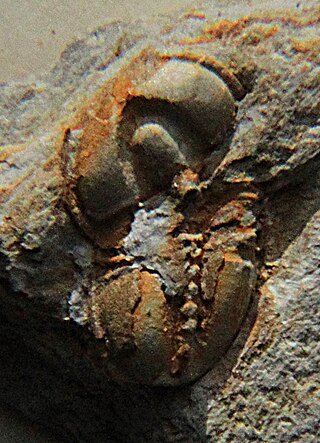
Eodiscina is trilobite suborder. The Eodiscina first developed near the end of the Lower Cambrian period and became extinct at the end of the Middle Cambrian. Species are tiny to small, and have a thorax of two or three segments. Eodiscina includes six families classified under one superfamily, Eodiscoidea.

Galbagnostus is an extinct genus of agnostid trilobite. It lived during the Lower and Middle Ordovician.

Sphaeragnostus is an extinct genus from a well-known class of fossil marine arthropods, the trilobites. It can be recognized by having two thorax segments, a totally effaced headshield, while the tailshield although effaced, has a clear furrow parallel to its border, and a short, convex, subcircular axis. It lived during the Ordovician.

Crustaceans belong to the subphylum Crustacea, and form a large, diverse group of arthropods including decapods, seed shrimp, branchiopods, fish lice, krill, remipedes, isopods, barnacles, copepods, opossum shrimps, amphipods and mantis shrimp. The crustacean group can be treated as a subphylum under the clade Mandibulata. It is now well accepted that the hexapods emerged deep in the Crustacean group, with the completed group referred to as Pancrustacea. The three classes Cephalocarida, Branchiopoda and Remipedia are more closely related to the hexapods than they are to any of the other crustaceans.
Tannudiscus Pokrovskaya (1959) is a genus of Eodiscinid trilobites belonging to the family Weymouthiidae Kobayashi T. (1943), Order Agnostida. It lived during the late Lower Cambrian, with remains found in Canada (Newfoundland), China (Gansu), The United Kingdom (England), and the Russian Federation.

The Artiopoda is a grouping of extinct arthropods that includes trilobites and their close relatives. It was erected by Hou and Bergström in 1997 to encompass a wide diversity of arthropods that would traditionally have been assigned to the Trilobitomorpha. Trilobites, in part due to their mineralising exoskeletons, are by far the most diverse and long lived members of the clade, with most records of other members, which lack mineralised exoskeletons, being from Cambrian deposits.
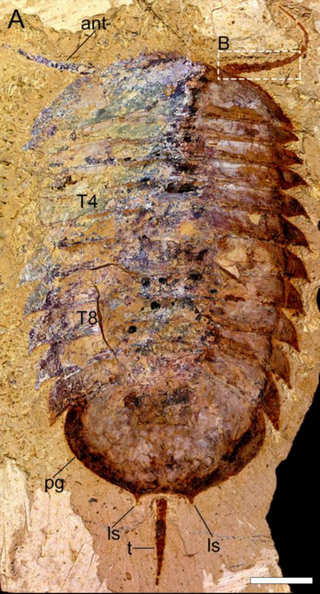
Retifacies abnormalis is an extinct arthropod that lived in the lower Cambrian. Its fossil remains have been found in the Maotianshan Shales of Yunnan, China. It is a member of the Artiopoda, and closely related to Pygmaclypeatus.
